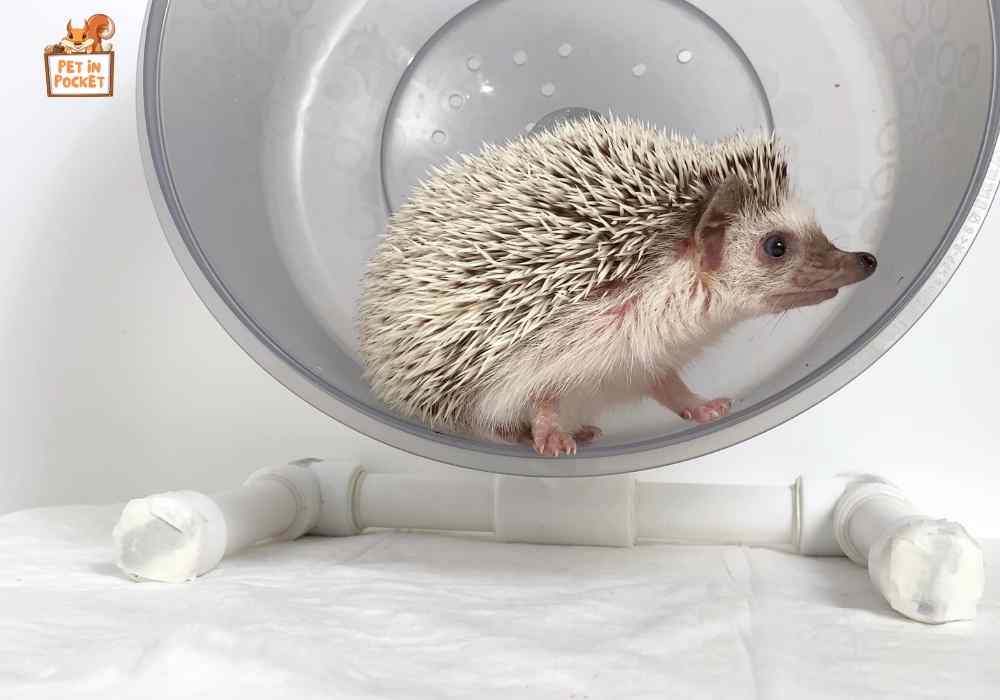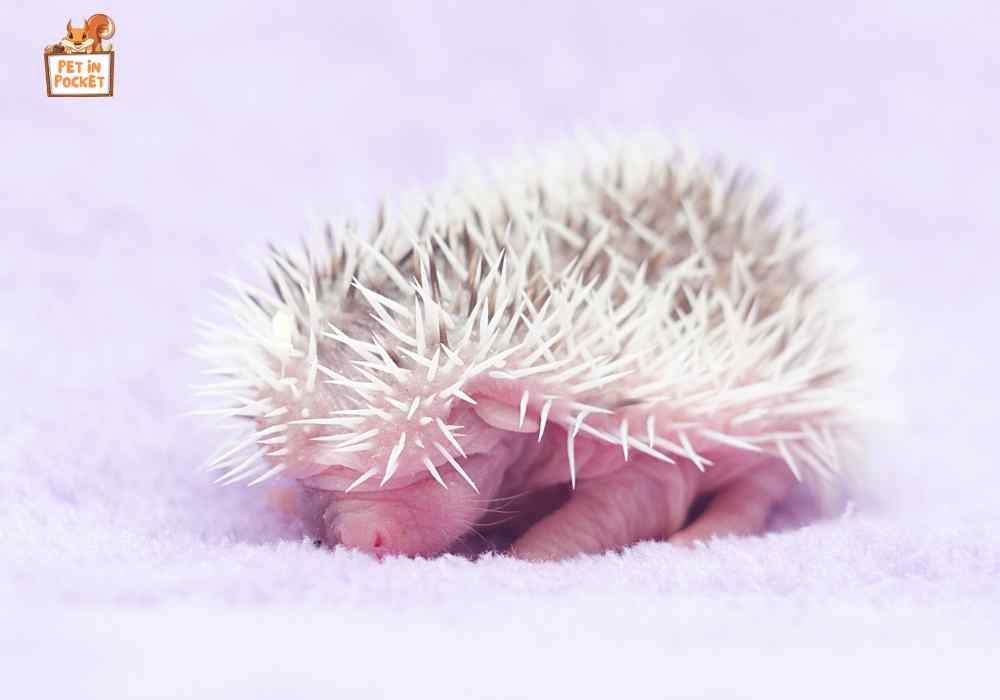Raising a hedgehog might look difficult from the outside. But, in reality, dealing with a hedgie takes less effort and energy. The trick here is to get your hands on the right care sheet. Yes, you have read it right.
See, all keepers have their own opinions on how to raise a hedgehog. Listening to everyone will just confuse you more. Instead, we advise you to stick to the basic care sheet at the start. You can customize it later according to your hedgie’s needs and personality.
For your convenience, you have added a detailed guide on how to take care of a hedgehog for beginners below.
Table of Contents
What Do You Need for A Hedgehog?: The Care Sheet
Hedgehogs have a lifestyle that is very different from our other pocket pets. For the starter, the hedgies are nocturnal. So, they sleep through the day and get active during the night. Hence, the housing arrangement must support such habits of the pets.
Let’s talk in more detail.
Housing: What Do We Need in A Hedgehog Cage?

Our little spikey friends have a habit of running miles after the dark. Hence, they demand an enclosure with large space to move. We recommend a 6-square-foot cage with enough enrichment available for the hedgies.
However, we understand if you can not manage the space for big enclosures. In such cases, buy a 2 square foot or 2 feet by 4 feet cage and install a running wheel inside. Don’t worry—this arrangement is absolutely healthy.
Well, you can not provide the hedgies with a bare cage. You must add toys and other decorations to keep the hedgehogs entertained. Otherwise, the pets will be bored and suffer from mental abnormality.
So, what toys are safe for our hedgehogs? We encourage you to keep at least a wheel in the cage. Besides, hedgies love playing with balls and paper tubes. These pets also appreciate hideouts inside the enclosure.
Another basic housing requirement for our quill balls is bedding. Hedgehogs are natural burrowers, and digging into the ground calms them down. Bioactive soil mix, aspen shavings, fabric layers, and paper shreds are our favorite substrates for the hedgies.
Bonus Tips
Do not use a wired bottom cage for the hedgehogs. This can severely injure the pets. Instead, a flat-floored enclosure is more suitable for these prickly pigs.
Creating The Perfect Environment for Hedgehogs

Our tiny hedgies hate chilly temperatures. As soon as the temperature drops drastically, they go into a torpor state. And we all know that hibernating hedgehogs in captivity is not the wisest decision.
Therefore, we should be very careful about the temperature range in the cage. Ideally, hedgehogs are more comfortable in 72F to 80F. The creatures will be extremely cold and slow down their activities if the temperature drops below 70F. We suggest installing a thermometer to track the temperature 24/7.
In summer and spring, the weather is just perfect for the hedgies. But in winter, you have to arrange heating pads and other heating sources to keep the hedgehogs warm.
As for the humidity, our prickly pigs are comfortable in a low moisture content. We maintain a less than 40% humidity in our hedgie enclosures.
Diet: What Do Hedgehogs Eat?

An ideal hedgehog diet must be high in protein. In the wild, these creatures forage on insects, worms, frogs, mice, and other protein sources. You have to match this nutritional need.
A chicken dinner is perfect for our little quill balls. But the same meal every day might bore the hedgehogs. That is why we have switched to a commercial diet.
Our hedgies thoroughly enjoy the dry packaged food available at the pet stores. Cat food or dog food is primarily filled with chicken. So, it can be an alternative to the packaged hedgehog meal.
Commercial pet items high in fat can be dangerous for the hedgie’s health. You better pick up a packaged meal with the following nutritional contents,
| Protein | 32% – 35% |
| Fat | <15% |
| By Products | No |
Now, we understand that hedgehogs love protein. But will they eat vegetables? The truth is that hedgies love munching on veggies, leafy greens, and fruits. Adding greens and fruits to the meal is not mandatory, but you can consider them treats.
Toss chopped apples, berries, carrots, corn, peas, etc., when the hedgehog is in its best behavior. Use this rewarding system to train your pet.
One more thing! Hedgehogs are hunters in the wild. The captive-breds have the same instinct of preying on insects and worms. We often leave worms and insects in our hedgie’s beddings. The pets take a great interest in this hunting game.
An Ideal Feeding Routine for Hedgehog
One or two tablespoons of dry food is enough for the hedgehogs. Experts suggest feeding approximately 8% of their body weight twice a day. Occasionally, sprinkle supplements on the meals to backup mineral requirements.
We use heavy, shallow bowls to offer the pets dry foods and treats. For water, we hang bottles in the cage. Many keepers set up the water station with shallow containers.
Sticking to a feeding schedule is crucial to avoiding obesity in hedgehogs. If you notice fat rolls growing in the pets, encourage them to run and exercise. Otherwise, the hedgies will suffer from physical complications.
We suggest regularly freeing your hedgehog for at least 30 minutes in a free space. This counts as a workout, and the stroll relaxes the pets.
Hedgehog Grooming Sessions

Our tiny quill balls are very picky about their personal hygiene. They demand regular baths to maintain the minimum cleanliness. Here is how you can bathe your hedgehogs,
- Fill up the sink with 1-inch lukewarm water.
- Place your hedgehog inside the pool without making their ears and face wet.
- Use a toothbrush to rub and clean their quills.
- After the bath, dry them with a towel.
If you notice your hedgehogs quilling (shedding spines), offer them an oatmeal bath to ease their discomfort.
Like regular baths, nail trimming is also necessary for hedgies as their nails grow fast. You can use a clipper to trim off the nails.
Hedgehog Health Care Tips
Our hedgies are quite sensitive. Dirty enclosure, improper temperature, a boring meal, etc., are enough to make these quill balls sick. Here are some signs that will help you determine the illness in your hedgehogs,
- Inactivity
- Long sleeping schedule
- Awake during the daytime
- Injuries
- Sunken or swollen eyes
- Obesity
- Drastic weight loss
- Green droppings
- Diarrhea
- Tattered ears
- Constant scratching
Take immediate action if you notice any of these symptoms in your hedgehog. The pet will recover with proper treatment and care. Furthermore, do not forget to bring the hedgies in for regular health checkups.
Is A Hedgehog Easy to Take Care of?

To be honest, hedgehogs are quite easy to take care of. They have no special demands whatsoever. These quill balls will thrive with only a spacious enclosure and a protein diet.
Yes, you might find it difficult to bond with the hedgehogs because of their shy nature. The trick here is to get involved with the hedgies as much as possible. For example, handle the pets so that they can recognize your scent and voice. Soon, the hedgehogs will act relaxed and comfortable around you.
These prickly pigs love solitude. So, housing two hedgies in a single cage will make the situation difficult for you. We advise you to raise a solo hedgehog and concentrate on offering it the best care.
A Special Tip on Hedgehog Enclosure Hygiene
Hedgehogs despise filthy cages. To avoid bacterial growth, remove the feces, urine, and uneaten meals every day.
You must also change the bedding once or twice a month. Otherwise, the substrate will lead to skin irritation and respiratory diseases.
Give the bottle and food dish a weekly scrub. The cage bars also need a soapy water rinse once a week.
Conclusion
Honestly, sticking to a care sheet is enough to keep the hedgehog healthy. As a result, the pets can now enjoy a longer life expectancy, around 4 to 6 years. Our beginner’s guide is enough to get you started with your hedgie. Follow our other posts for in-depth information on hedgehog care.
FAQs
How to raise a pet hedgehog?
Offer the hedgehog a cage at least 2 square feet decorated with wheels and toys. Provide them with protein-rich food every day. Do not forget their occasional grooming sessions. Finally, take the pets for regular vet checkups.
What do you need to know before owning a hedgehog?
Learning the behavior and researching care sheets are mandatory before bringing a hedgehog home. It will give you an idea of what to expect from the pet. Otherwise, the pet will suffer in the long run.
Is it OK to touch a hedgehog?
Hedgehogs might not like your touch in the beginning. But if you make them feel safe, they stop resisting your petting. In fact, the hedgies enjoy it when you scratch their chins, ears, and belly furs and stroke the quills.
How to make a hedgehog happy?
Occasional treats make the hedgehogs instantly happy. Besides, these animals love running and playing games. So, installing wheels, tunnels, and other puzzling toys in the enclosure will also keep them entertained and engaged.
Is a hedgehog friendly?
Hedgehogs are shy and take time to bond with humans. When you keep handling the hedgies, they start recognizing your scent and voice. Then, they will act relaxed and more responsive around you.






Leave a Reply